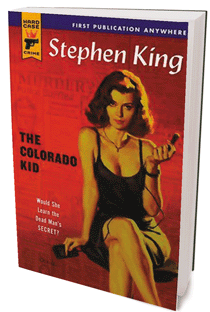
When Stephen King received a lifetime-achievement award from the National Book Awards in 2003, literary critic Harold Bloom threw a fit. "He is a man who writes what used to be called penny dreadfuls," Bloom ranted. "That they could believe that there is any literary value or any aesthetic accomplishment or signs of an inventive human intelligence is simply a testament to their own idiocy." It’s a safe bet Bloom didn’t run to his local bookstore and pick up King’s latest, The Colorado Kid. Too bad. A thoughtful tribute to the pulp classics of the 1940s and 50s, it is just the latest installment in an increasingly diverse and interesting body of work, including foreshadowings of high-school shootings and reality TV, written under the pseudonym Richard Bachman. And more recently, King has made forays into non-fiction with essays like "Head Down," about coaching his son’s Little League baseball team, and an unassuming memoir, On Writing: A Memoir of the Craft.
The Colorado Kid is hard-boiled pulp on the surface, but dig down a few inches and it’s a rumination on the art of storytelling. Set on fictional Moose-Lookit Island, Maine, the story opens with Vince Teague and Dave Bowie, editors of the Weekly Islander newspaper, and their young intern, Stephanie McCann, having lunch with Hanratty, a scoop-hunting reporter from the Boston Globe. The weathered old newspapermen stonewall Hanratty right off the island, and back at the office, in a sort of downeast initiation ceremony, they tell Stephanie the story of the unidentified Colorado man found dead on the island’s beach 25 years earlier.
Well-traveled ground so far, but King doesn’t stick to the beaten path for long. The average crime novel would plunge into a flashback, recounting the crime and cracking the case in a breathless, as-if-you-were-there style, but this narrative never leaves the offices of the Weekly Islander. Vince and Dave do all the heavy lifting —explaining the hunk of steak lodged in the dead man’s gullet, and how he made it from Colorado to Maine. The two "old buzzards," as Stephanie calls them, also teach the aspiring journalist a lesson about stories: it’s the ones without endings that ignite the imagination and are most worth telling.
The Colorado Kid owes a huge debt to pulp writers of the past. One of the hallmarks of crime fiction is the use of simple, stripped-down descriptions that belie a far more complex reality. Here King excels, describing a dead body as feeling "like wood under that white shirt," but balances with it a laconic pacing that mirrors the speed of island life. In one passage, Dave interrupts the story at a critical moment and asks if anyone wants a snack. It’s a way of taking a breath and appreciating the web being spun before the reader’s eyes: "It turned out they all were, and story-time was suspended until Dave brought them back, along with a roll of paper towels. When each of them had a Labree’s squash muffin and a paper towel to catch the crumbs, Vince told Dave to take up the tale." In its way, The Colorado Kid is also a tribute to Yankee yarn spinners like Dave and Vince who populate Maine towns from Kittery to Caribou.